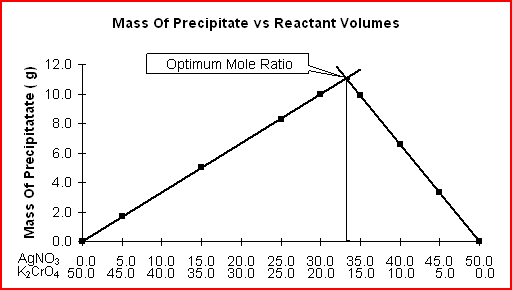Determining The Stoichiometry Of Chemical Reactions

A balanced chemical equation gives the mole ratios of reactants and products in a chemical reaction. How can the stoichiometry of a chemical reaction be determined experimentally? This experiment uses the method of continuous variations to determine the mole ratio of the two reactants.
In the method of continuous variations, the total number of moles of reactants is kept constant for a series of measurements. Each measurement is made with a different mole ratio or mole fraction of reactants. The maximum change will occur when the mole ratio of the reactants is closest to the optimum ratio which is the stoichiometric ratio in the chemical equation.
An extensive property of the reaction that depends on the amount of product formed is measured. This property may be the color intensity of a reactant or product, the mass of a precipitate, the amount of heat produced, or the volume of a gas evolved. A typical set of results for this investigation is shown below.
| Experiment |
Volume AgNO3 |
Volume K2CrO4 |
Mass Of Precipitate |
|---|---|---|---|
Number |
(mL) |
(mL) |
(g) |
1 |
0.0 |
50.0 |
0.0 |
2 |
5.0 |
45.0 |
1.7 |
3 |
15.0 |
35.0 |
5.0 |
4 |
25.0 |
25.0 |
8.3 |
5 |
30.0 |
20.0 |
10.0 |
6 |
35.0 |
15.0 |
9.9 |
7 |
40.0 |
10.0 |
6.6 |
8 |
45.0 |
5.0 |
3.3 |
9 |
50.0 |
0.0 |
0.0 |
 |
The graph shows that the amount of product increases in a continuous manner and then decreases. To find the optimum mole ratio, two best-fit straight lines are drawn with their intersection being the maximum change. The maximum change occurs when when each reactant is a limiting reactant. As shown above, the region where the volume of AgNO3 (mole ratio) increases from 0 to ≈ 33 mL shows the AgNO3 to be the limiting reactant. The intersection shows the maximum mole ratio and now K2CrO4 becomes the limiting reactant.
The optimum mole (volume) ratio is 33 mL AgNO3/17 mL K2CrO4 or 2:1 which is the stoichiometric mole ratio as well as the ratio of moles in the empirical formula for Ag2CrO4.
2AgNO3(aq) + K2CrO4(aq) → 2KNO3(aq) + Ag2CrO4(s)
2Ag+(aq) + CrO42-(aq) → Ag2CrO4(s)
©2004, Flinn Scientific, Inc. All Rights Reserved. Reproduced for one-time use with permission from Flinn Scientific, Inc., Batavia, IL, USA. No part of this material may be reproduced or transmitted in any form or by any means, electronic or mechanical, including, but not limited to photocopy, recording, or any information storage and retrieval system, without permission in writing from Flinn Scientific, Inc.; and
That the Licensee agrees to indemnify and hold Flinn Scientific, Inc. harmless from any and all liability, loss, damages, costs of expense which Flinn Scientific, Inc. may hereafter incur, suffer or be required to pay by reason of such publication by the Licensee; and
To compensate Flinn Scientific, Inc. $0.00 for the permission to reproduce this material.